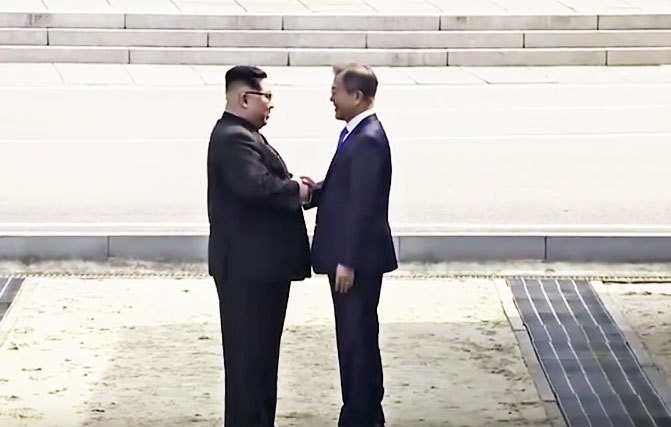By Jan Oberg
Please watch the video below carefully. You’ll see what could – could, and most likely will – become a piece of world peace history. Note the body language of the two leaders – warm smiles and long handshakes. In spite of being one and the same nation, they meet at the hardest border in the world.
Why is it so? Because everybody else around – the US, Japan, Russia, China – to varying degrees want them to be divided and feel threatened by their possible unification. And yes, a unified Korea would be a formidable economic power but a huge, dangerous conflict would be gone, the US could withdraw, Japan would get a chance to reconciliate in substantive terms.
What is most amazing in this clip is that Kim first steps over the border line into the South. Then – seemingly surprising Moon – invites Moon to step into the North, hand in hand. Hear the people nearby applauding.
This is historic peace-making in-the-making.
So much more convincing and promising than today’s Western/NATO norm: “peace” by violence, imposed from the outside. By us/US.
Here are two statesmen and the Western derogative image of Kim must now be a thing of the past.
I’m personally very tired of all the media and political commentators who, without a second thought, support NATO countries’ bombing in the name of peace, democracy and human rights – today mustsay that it could all be a ploy by “the Rocket Man”. Kim and the people around him are obviously very competent politicians with a longterm strategy.
In these otherwise dark times, let’s be hopeful that peace is what it will really unfold – a peace that takes place without the US or other foreign parties. It’s genuinely Korean thanks to both historical developments but also two personalities who both seem to have the right attitude and build on what all conflict-resolution must focus on: An identification of common or overlapping interests combined with a view of the future that is so much more benefit than continue enmity.
• •
I shall never forget when, about 20 years, ago I participated in an international peace conference in Seoul – and also visited this border and De-Militarized Zone (DMZ). On the last day there was a delightful dinner in a banquet hall and, as an end to the conference, the Korean participants rose and sang the South Korean national anthem “Aegukga” which, I was told, should be interpeted as expressive of the one-ness, the unity of the Korean people. Both sides!
I can’t say how many, but many in that hall had tears in their eyes, some crying and their voices trembling. I felt both surprised and very moved by the intense emotional charge there and then.
While there may be many in the two Koreas who are hesitant to unification, particularly among the younger generations, I believe the large majority want it, at least in a step-by-step process. The very least the rest of the world should do is to respect that one people has a right to be re-unified if they so want and that nobody has a right to deny them that right.
• •
Body language and symbol politics has changed the entire world before. When Gandhi came to the Dandi coast at the end of his long Salt March, he picked up salt from the ground, held it up and said: “This is ours” – in defiance of the British colnial administration that maintained that this salt – too – belonged to Britain. Seventeen years later, India became independent.
When German chancellor, Willy Brandt, one of the greatest politicians in my generation – knelt down at the monument in Warsaw, spontaneously, to apologize for the crimes of Nazi Germany he changed European history. He did what very few politicians have the civil courage to do: he apologised for his country and his people’s wrongdoing to another people.
Brandt thereby also opened the way for his next brilliant move for Europe – the detente policy with the Soviet Union (something no Western politician would even think of today vis-a-vis Russia) and the “Ostpolitik” that lead eventually also to unification of the two Germanys.
• •
If what we saw this morning in Korea is allowed – allowed by all the others – to find its own path, it won’t take decades before we can see one of the world’s hardest conflicts de-escalate and trust and cooperation develop and eventually what most Korean people deeply want: to be the one country, the unified nation, they have a historical, collective human right to become.
Could every body else please leave the Koreans alone and in peace to do together what they want.
And could the West, the U.S. in particular, please be supportive of genuine, indigenous peace process and, as a goodwill step, withdraw just a few of its military vessels from the region – but many enough to make it a visible goodwill gesture.
There is also this video by Washington Post
PS It’s fun how feet obviously can play a role in peace-making – but guided by good will and expression of humanity. Gandhi walked about 300 kilometres on his and achieved independence. Brandt used his feet and knees to change Europe. And this morning the two Korean leaders took steps towards peace by inviting each other to set foot on the territory of the other.
Readings










